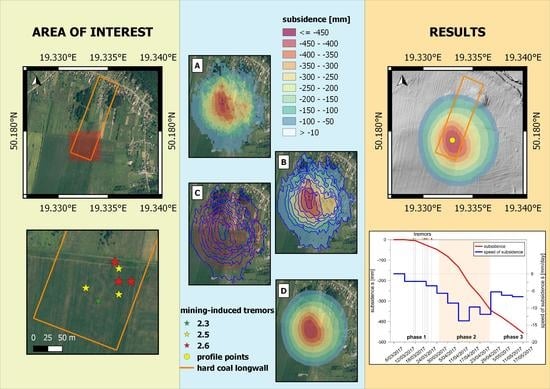Land Surface Subsidence Due to Mining-Induced Tremors in the Upper Silesian Coal Basin (Poland)—Case Study
Abstract
:1. Introduction
2. Materials and Methods
2.1. Area of Interest
2.2. SAR Data Acquisition and Processing
2.3. Determination of Subsidence Trough
3. Results
4. Discussion
5. Conclusions
Author Contributions
Funding
Conflicts of Interest
Appendix A

References
- Chrousos, G.P.; Loriaux, D.L.; Gold, P.W. Mechanisms of Physical and Emotional Stress; Springer: Boston, MA, USA, 1988; Volume 245, ISBN 9788578110796. [Google Scholar]
- Brady, B.H.G.; Brown, E.T. Rock Mechanics; Springer: Dordrecht, The Netherlands, 1999; ISBN 978-0-412-47550-4. [Google Scholar]
- Durrheim, R.; Anderson, R.; Cichowiczc, A.; Ebrahim-Trolloped, R.; Huberte, G.; Kijkoc, A.; McGarrf, A.; Ortleppg, W.D.; Van der Merwe, N. The risks to miners, mines, and the public posed by large seismic events in the gold mining districts of South Africa. In Proceedings of the 3rd International Seminar on Deep and High Stress Mining 2006, Quebec, QC, Canada, 2–4 October 2006; p. 14. [Google Scholar]
- Rudziński, L.; Mirek, J.; Lizurek, G. Identification of seismic doublets occurred on Rudna mine, Poland. Acta Geophys. 2017, 65, 287–298. [Google Scholar] [CrossRef] [Green Version]
- Fritschen, R. Mining-induced seismicity in the Saarland, Germany. Pure Appl. Geophys. Pageoph 2009, 167, 77–89. [Google Scholar] [CrossRef]
- Spetzler, J.; Dost, B. Hypocentre estimation of induced earthquakes in Groningen. Geophys. J. Int. 2017, 209, 453–465. [Google Scholar]
- Gibowicz, S.; Droste, Z.; Guterch, B.; Hordejuk, J. The Belchatow, Poland, earthquakes of 1979 and 1980 induced by surface mining. Eng. Geol. 1981, 17, 257–271. [Google Scholar] [CrossRef]
- Szczerbowski, Z. High-energy seismic events in Legnica-Głogów Copper District in light of ASG-EUPOS data. Reports Geod. Geoinformatics 2019, 107, 25–40. [Google Scholar] [CrossRef] [Green Version]
- Szczerbowski, Z. Mining induced seismic events and surface deformations monitored by GPS permanent stations. Acta Geodyn. Geomater. 2015, 12, 237–248. [Google Scholar] [CrossRef] [Green Version]
- Kaláb, Z. Impact of seismicity on surface in mining affected areas: General description. Acta Geodyn. Geomater. 2004, 1, 35–39. [Google Scholar]
- Mutke, G.; Dubiński, J.; Lurka, A. New criteria to assess seismic and rock burst hazard in coal mines. Arch. Min. Sci. 2015, 60, 743–760. [Google Scholar] [CrossRef] [Green Version]
- Witkowski, M.; Wodyński, A. Analysis of mining damage notifications in single-family buildings after the occurrence of intensive mining tremors. Geomat. Environ. Eng. 2015, 9, 101. [Google Scholar] [CrossRef] [Green Version]
- Wodyński, A.; Lasocki, S. Assessment of mining tremor inflence on the technical wear of building. Acta Geodyn. Geomater. 2004, 1, 187–194. [Google Scholar]
- Bryt-Nitarska, I. Effects of strong mining tremors, and assessment of the buildings’ resistance to the dynamic impacts. E3S Web Conf. 2018, 36, 01003. [Google Scholar] [CrossRef] [Green Version]
- Kobayashi, T.; Morishita, Y.; Yarai, H.; Fujiwara, S. InSAR-derived crustal deformation and reverse fault motion of the 2017 Iran-Iraq earthquake in the Northwest of the Zagros Orogenic Belt. Bull. Geospat. Info. Auth. Jpn. 2017, 1–9. [Google Scholar]
- Sreejith, K.M.; Sunil, P.; Agrawal, R.; Saji, A.P.; Ramesh, D.S.; Rajawat, A.S. Coseismic and early postseismic deformation due to the 25 April 2015, M w 7.8 Gorkha, Nepal, earthquake from InSAR and GPS measurements. Geophys. Res. Lett. 2016, 43, 3160–3168. [Google Scholar] [CrossRef] [Green Version]
- Bayer, B.; Simoni, A.; Schmidt, D.A.; Bertello, L. Using advanced InSAR techniques to monitor landslide deformations induced by tunneling in the Northern Apennines, Italy. Eng. Geol. 2017, 226, 20–32. [Google Scholar] [CrossRef]
- Schlögel, R.; Doubre, C.; Malet, J.P.; Masson, F. Landslide deformation monitoring with ALOS/PALSAR imagery: A D-InSAR geomorphological interpretation method. Geomorphology 2015, 231, 314–330. [Google Scholar] [CrossRef]
- Ilieva, M.; Polanin, P.; Borkowski, A.; Gruchlik, P.; Smolak, K.; Kowalski, A.; Rohm, W. Mining Deformation life cycle in the light of InSAR and deformation models. Remote Sens. 2019, 11, 745. [Google Scholar] [CrossRef] [Green Version]
- Ng, A.H.-M.; Ge, L.; Du, Z.; Wang, S.; Ma, C. Satellite radar interferometry for monitoring subsidence induced by longwall mining activity using Radarsat-2, Sentinel-1 and ALOS-2 data. Int. J. Appl. Earth Obs. Geoinf. 2017, 61, 92–103. [Google Scholar] [CrossRef]
- Pawluszek-Filipiak, K.; Borkowski, A. Integration of DInSAR and SBAS Techniques to determine mining-related deformations using sentinel-1 data: The case study of Rydułtowy mine in Poland. Remote Sens. 2020, 12, 242. [Google Scholar] [CrossRef] [Green Version]
- Guzy, A.; Malinowska, A.A. State of the art and recent advancements in the modelling of land subsidence induced by groundwater withdrawal. Water 2020, 12, 2051. [Google Scholar] [CrossRef]
- Cuenca, M.C.; Hooper, A.; Hanssen, R.F. Surface deformation induced by water influx in the abandoned coal mines in Limburg, The Netherlands observed by satellite radar interferometry. J. Appl. Geophys. 2013, 88, 1–11. [Google Scholar] [CrossRef]
- Malinowska, A.; Witkowski, W.T.; Guzy, A.; Hejmanowski, R. Satellite-based monitoring and modeling of ground movements caused by water rebound. Remote Sens. 2020, 12, 1786. [Google Scholar] [CrossRef]
- Milczarek, W.; Blachowski, J.; Grzempowski, P. Application of PSInSAR for assessment of surface deformations in post-mining area-case study of the former Walbrzych Hard Coal Basin (SW Poland). Acta Geodyn. Geomater. 2016, 14, 41–52. [Google Scholar] [CrossRef]
- Vervoort, A.; Declercq, P.-Y. Surface movement above old coal longwalls after mine closure. Int. J. Min. Sci. Technol. 2017, 27, 481–490. [Google Scholar] [CrossRef]
- Chaussard, E.; Wdowinski, S.; Cabral-Cano, E.; Amelung, F. Land subsidence in central Mexico detected by ALOS InSAR time-series. Remote Sens. Environ. 2014, 140, 94–106. [Google Scholar] [CrossRef]
- Chen, M.; Tomás, R.; Li, Z.; Motagh, M.; Li, T.; Hu, L.; Gong, H.; Li, X.; Yu, J.; Gong, X.-L. Imaging land subsidence induced by groundwater extraction in Beijing (China) using satellite radar interferometry. Remote Sens. 2016, 8, 468. [Google Scholar] [CrossRef] [Green Version]
- Krawczyk, A.; Grzybek, R. An evaluation of processing InSAR Sentinel-1A/B data for correlation of mining subsidence with mining induced tremors in the Upper Silesian Coal Basin (Poland). E3S Web Conf. 2018, 26, 00003. [Google Scholar] [CrossRef] [Green Version]
- Mirek, K.; Mirek, J. Observation of underground exploitation influence on a surface in Budryk, Sośnica, and Makoszowy Coal Mine Area. Pol. J. Environ. Stud. 2016, 25, 57–61. [Google Scholar]
- Rudziński, L.; Mirek, K.; Mirek, J. Rapid ground deformation corresponding to a mining-induced seismic event followed by a massive collapse. Nat. Hazards 2018, 96, 461–471. [Google Scholar] [CrossRef] [Green Version]
- Hejmanowski, R.; Malinowska, A.; Witkowski, W.T.; Guzy, A. An analysis applying InSAR of subsidence caused by nearby mining-induced earthquakes. Geosciences 2019, 9, 490. [Google Scholar] [CrossRef] [Green Version]
- Malinowska, A.; Witkowski, W.T.; Guzy, A.; Hejmanowski, R. Mapping ground movements caused by mining-induced earthquakes applying satellite radar interferometry. Eng. Geol. 2018, 246, 402–411. [Google Scholar] [CrossRef]
- Milczarek, W.J. Application of a small baseline subset time series method with atmospheric correction in monitoring results of mining activity on ground surface and in detecting induced seismic events. Remote Sens. 2019, 11, 1008. [Google Scholar] [CrossRef] [Green Version]
- Hejmanowski, R.; Malinowska, A.; Stoch, T.; Pluciński, P.; Warchała, M.; Kosior, R. New interpretation of GPS measurements results. Miner. Resour. Manag. 2008, 24, 197–204. [Google Scholar]
- Popiołek, E.; Ostrowski, J.; Czaja, J.; Mazur, J. The impact of a strong mining tremor on the subsidence of the area surface in the Legnica-Glogow Copper Area. In Proceedings of the 10th FIG International Symposium on Deformation Measurements, Orange, CA, USA, 19–22 March 2001; pp. 77–80. [Google Scholar]
- Kowalski, A. Surface Deformation in Upper Silesian Coal Basin; Central Mining Institute: Katowice, Poland, 2015. (In Polish) [Google Scholar]
- IS EPOS Episode: USCB. Available online: https://tcs.ah-epos.eu/#episode:USCB, (accessed on 30 October 2020).
- Okoń, A.; Wróbel, A.; Poznański, G. Exploitation of seam 209 in seismic hazard conditions at ZG “Sobieski”. Bezp. Pr. Ochr. Śr. Gór. 2010, 6, 23–28. [Google Scholar]
- Drzewiecki, J.; Myszkowski, J. Mining-induced seismicity of a seam located in rock mass made of thick sandstone layers with very low strength and deformation parameters. J. Sustain. Min. 2018, 17, 167–174. [Google Scholar] [CrossRef]
- Kozłowska, M.; Orlecka-Sikora, B.; Rudziński, Ł.; Cielesta, S.; Mutke, G. Atypical evolution of seismicity patterns resulting from the coupled natural, human-induced and coseismic stresses in a longwall coal mining environment. Int. J. Rock Mech. Min. Sci. 2016, 86, 5–15. [Google Scholar] [CrossRef]
- Mutke, G.; Kotyrba, A.; Lurka, A.; Olszewska, D.; Dykowski, P.; Borkowski, A.; Araszkiewicz, A.; Barański, A. Upper Silesian geophysical observation system a unit of the EPOS project. J. Sustain. Min. 2019, 18, 198–207. [Google Scholar] [CrossRef]
- Hejmanowski, R.; Kwinta, A. Determining the coefficient of horizontal displacements with the use of orthogonal polynomials. Arch. Min. Sci. 2009, 54, 441–454. [Google Scholar]
- Stoch, T.; Niedojadło, Z.; Sopata, P.; Moskała, S. Functions approximating the average course of deformation indicators for the determination of the random dispersion parameters of the post-mining dislocations and land surface deformations. Prz. Gór. 2014, 70, 113–123. (In Polish) [Google Scholar]
- Hejmanowski, R.; Stoch, T.; Sopata, P.; Wójcik, A.; Witkowski, W.T. Effect of coal strata dewatering on land surface subsidence. Prz. Gór. 2013, 8, 38–43. (In Polish) [Google Scholar]
- Witkowski, W.T. Subsidence changes modeling in drainage basin by use of the trend method. Prz. Gór. 2013, 7, 35–40. (In Polish) [Google Scholar]
- Niedojadło, Z.; Stoch, T.; Sopata, P.; Wójcik, A. Analysis of the Results of Geodetic Observations on Observation Lines and Surface Infrastructure Facilities, the Goal Verification of Design Assumptions Adopted for Indicator Forecasts Deformation of the Area within TG ZG “Sobieski” for TAURON Wydobycie; Scientific and Research Study: Kraków, Poland, 2016. (In Polish) [Google Scholar]
- Kratzsch, H. Mining Subsidence Engineering; Springer: Berlin, Germany; New York, NY, USA, 1983; ISBN 13:978-3-642-81925-4. [Google Scholar]
- National Coal Board Subsidence Engineering Handbook; NCB: London, UK, 1975.
- Peng, S.S.; Ma, W.M.; Zhong, W.L. Surface Subsidence Engineering; Society for Mining, Metallurgy, and Exploration: Littleton, CO, USA, 1992; ISBN 0873351142. [Google Scholar]
- Rogowska, J.; Knothe, S.; Gustkiewicz, J.; Popiołek, E.; Kanciruk, A.; Ostrowski, J.; Hejmanowski, R.; Pielok, W.; Leśniak, J.; Cygan, J.; et al. The Influence of the Halting of the Front. of Underground Exploitation on the Course of the Translocations and Deformations of the Area; Rogowska, J., Ed.; Strata Mechanics Research Institute of the Polish Academy of Science: Kraków, Poland, 2004. (In Polish) [Google Scholar]
- Kowalski, A. Land Deformation in the Mining Areas of Hard Coal Mines; Central Mining Institute: Katowice, Poland, 2020; ISBN 978-83-65503-23-7. (In Polish) [Google Scholar]
- Sroka, A. Dynamics of Mining Exploitation from Point of View Mining Damage; The Publishing House of the Mineral and Energy Economy, Research Institute of the Polish Academy of Sciences: Kraków, Poland, 1999. (In Polish) [Google Scholar]
- Sroka, A. Der Einfluss von Hochleistungsstreben auf das Gebirge und die Tagesoberfläche. Glückauf Forsch. 2003, 64. [Google Scholar]
- Sroka, A. Influence of time-based parameters of longwall panel exploitation on objects inside rock mass and on the surface. Arch. Min. Sci. 2009, 54, 819–826. [Google Scholar]
- Knothe, S. Effect of time on formation of basin subsidence. Arch. Min. Steel Ind. 1953, 1, 1–7. [Google Scholar]
- Malinowska, A. Analysis of methods used for assessing damage risk of buildings under the influence of underground exploitation in the light of world’s experience-Part 1. Arch. Min. Sci. 2013, 58, 843–853. [Google Scholar]
- Malinowska, A. Accuracy estimation of the approximated methods used for assessing risk of buildings damage under the influence of underground exploitation in the light of world’s and polish experience-Part 2. Arch. Min. Sci. 2013, 58, 855–865. [Google Scholar]
- Popiołek, E. Protection of Mining Areas; AGH-UST Publishing House: Kraków, Poland, 2009; ISBN 978-83-7464-229-3. (In Polish) [Google Scholar]
- Ostrowski, J. Surface Deformations of Protected Mining Area; Agencja Wydawniczo-Poligraficzna Art-Tekst: Kraków, Poland, 2015; ISBN 978-83-7783-124-3. (In Polish) [Google Scholar]
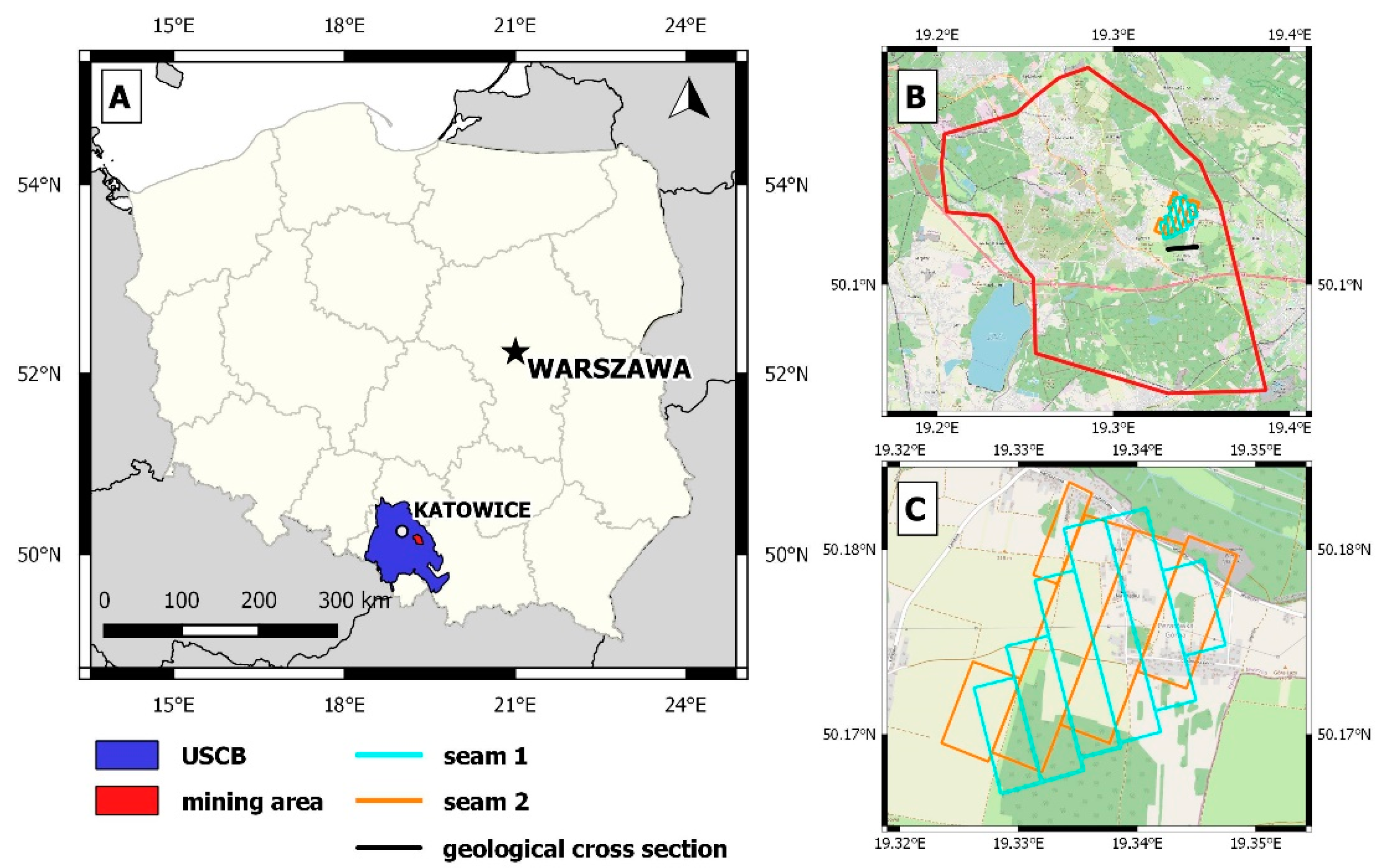



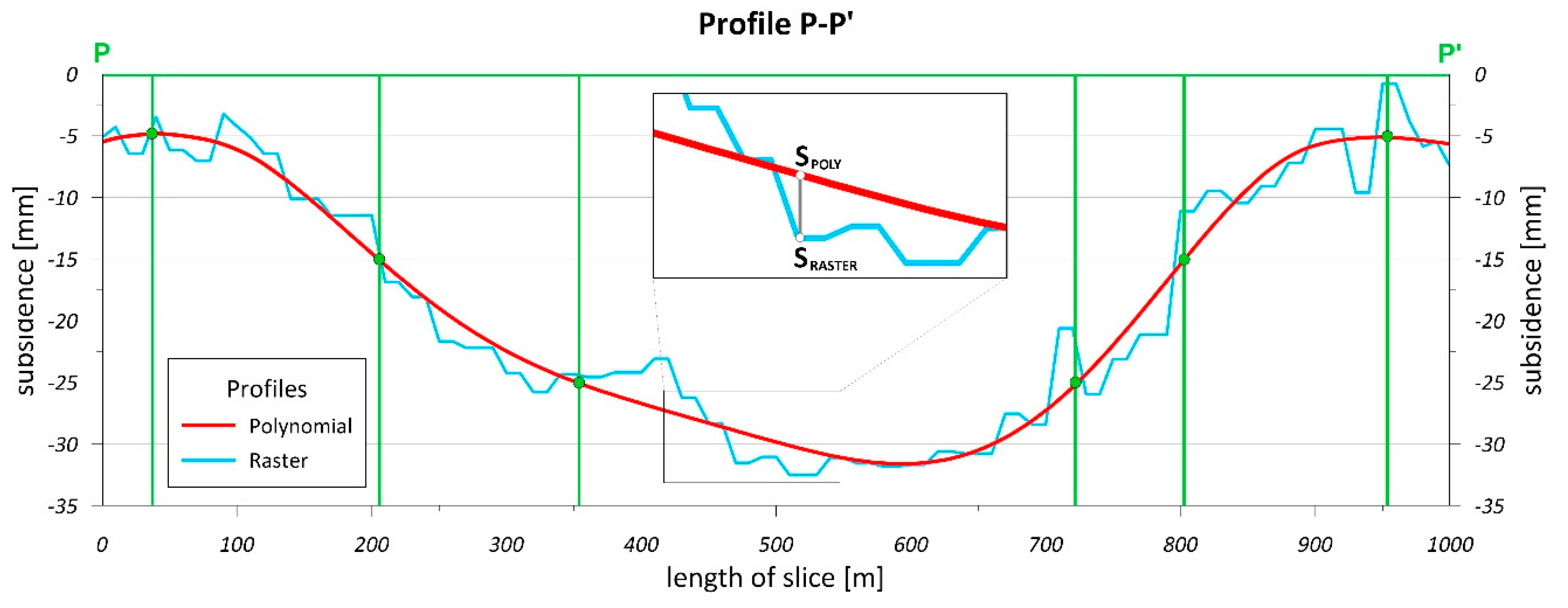

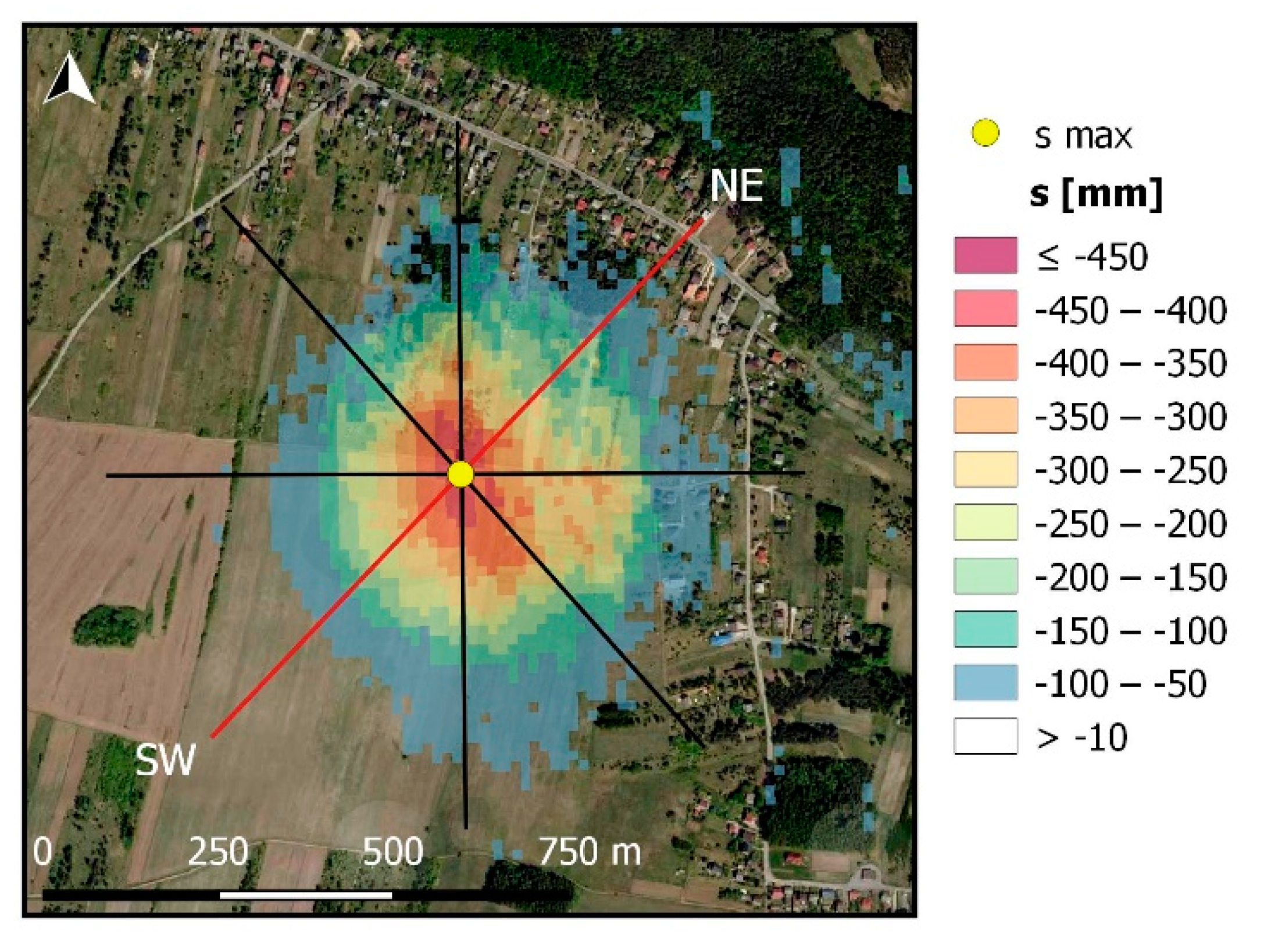
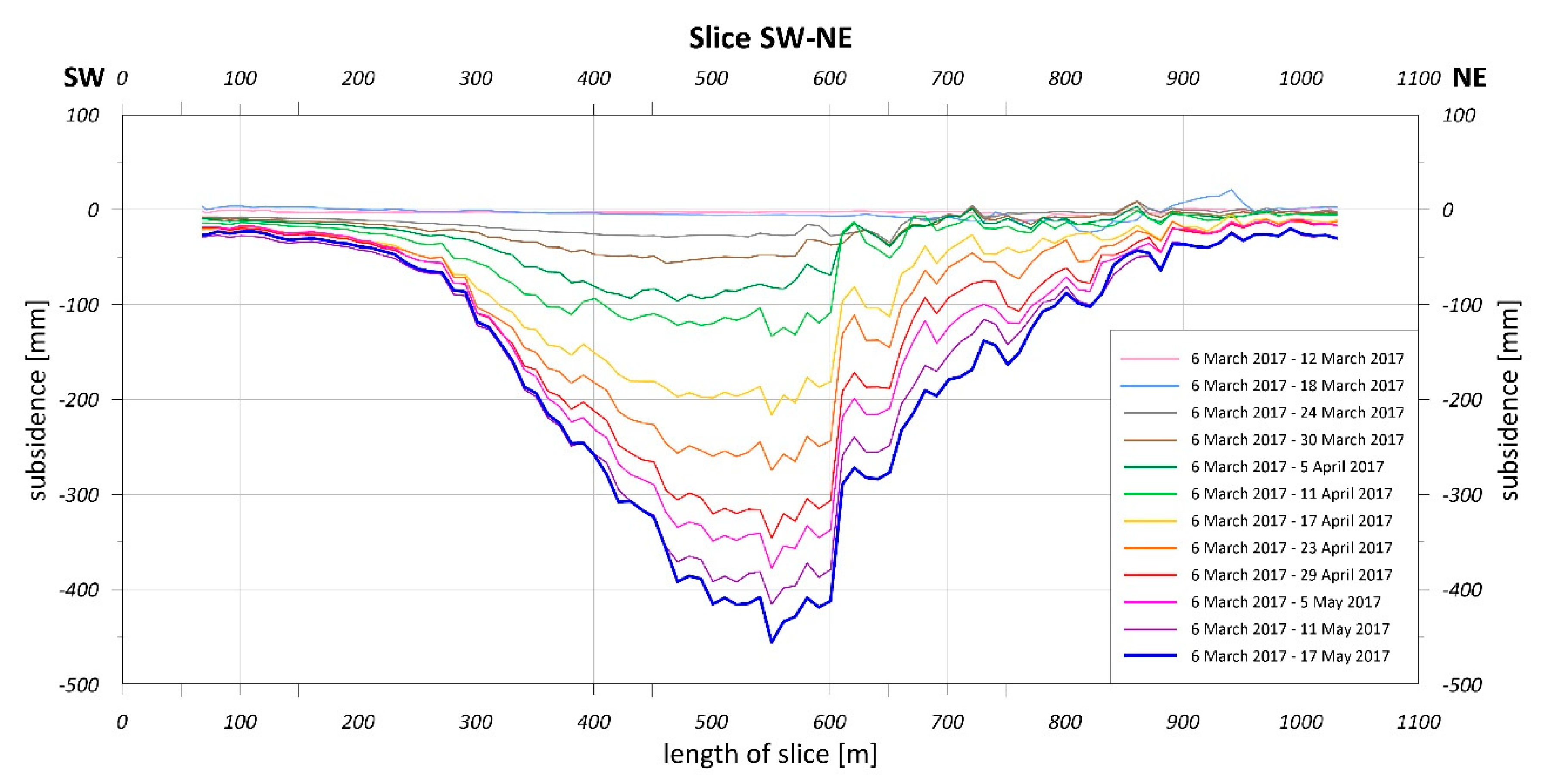
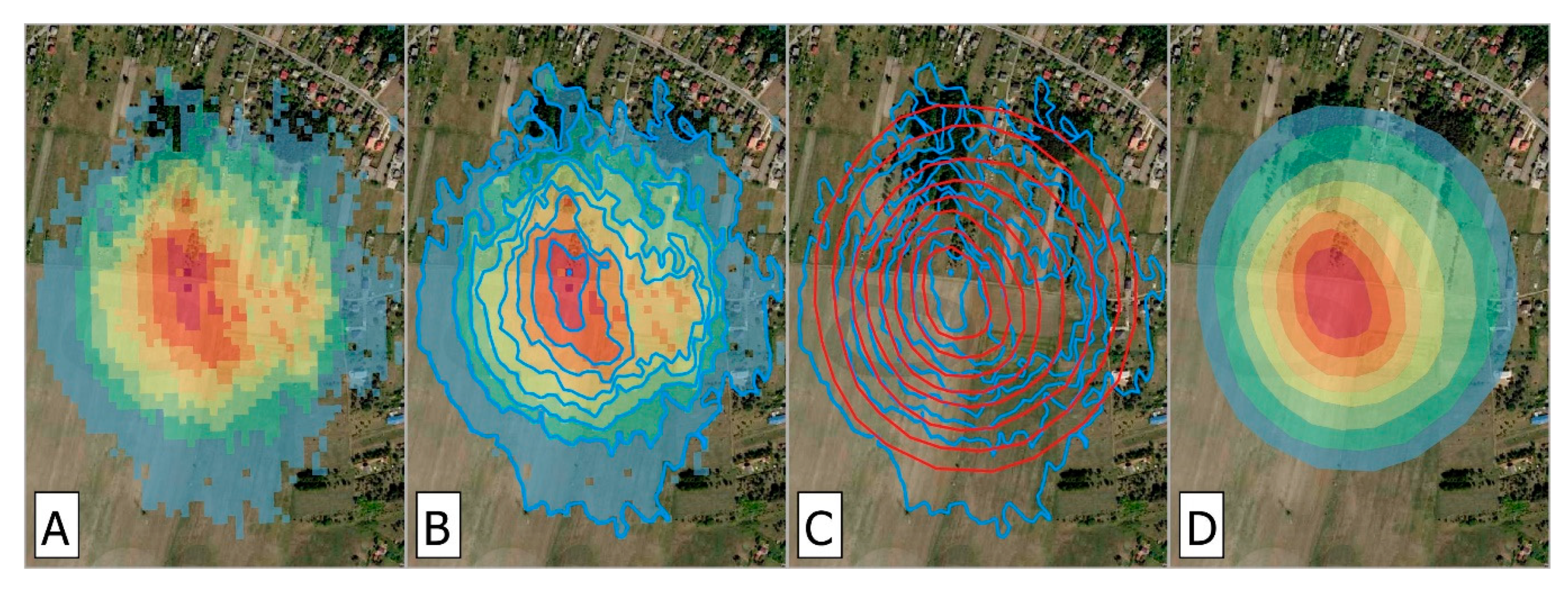


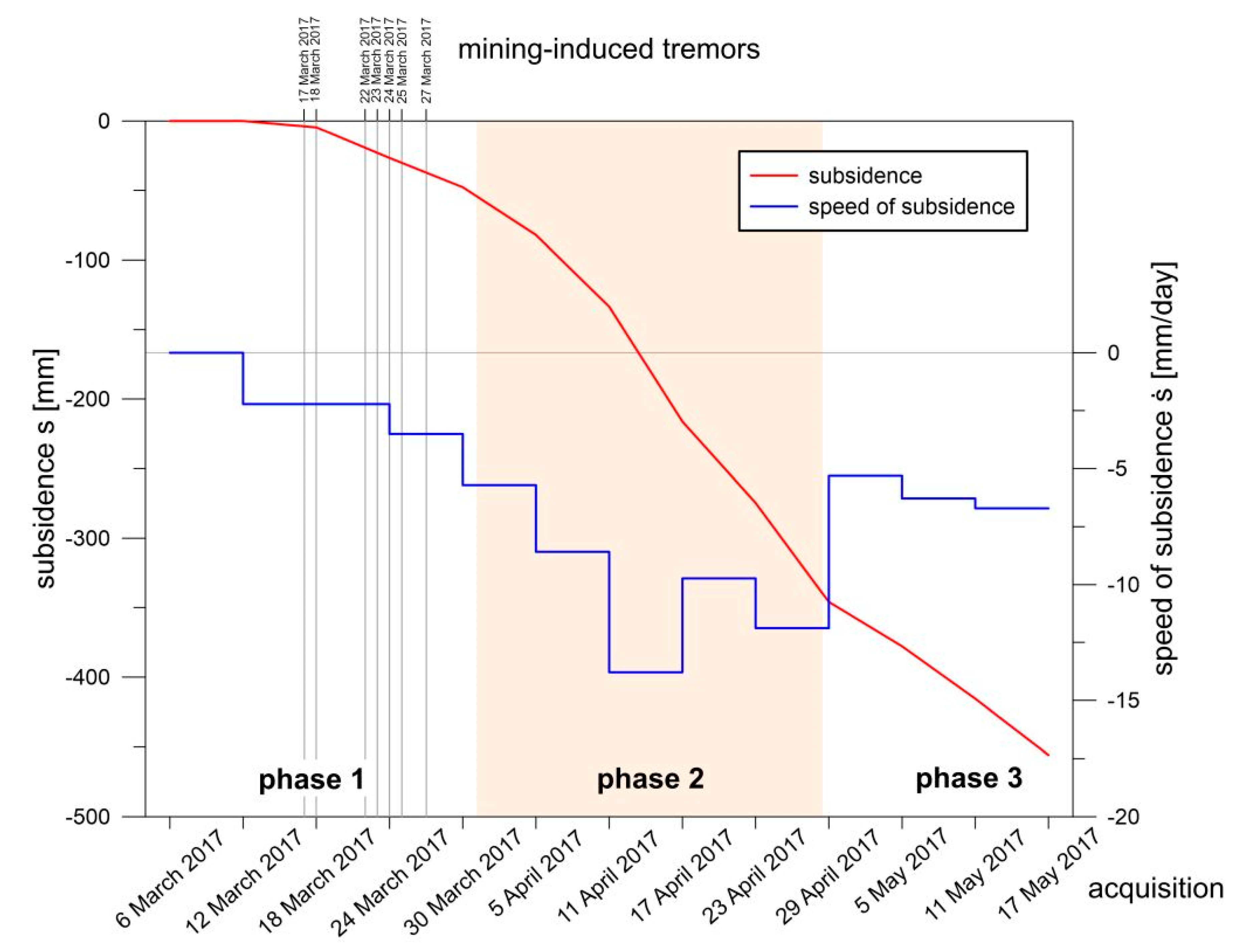
| Date dd/mm/yyyy | Time (UTC) | Longitude [deg] | Latitude [deg] | Local Magnitude ML |
|---|---|---|---|---|
| 17 March 2017 | 17:30 | 50.1789 N | 19.3328 E | 2.3 |
| 18 March 2017 | 16:37 | 50.1791 N | 19.3325 E | 2.5 |
| 22 March 2017 | 05:02 | 50.1790 N | 19.3333 E | 2.5 |
| 23 March 2017 | 06:00 | 50.1792 N | 19.3333 E | 2.6 |
| 24 March 2017 | 15:44 | 50.1792 N | 19.3336 E | 2.6 |
| 25 March 2017 | 11:59 | 50.1794 N | 19.3333 E | 2.5 |
| 27 March 2017 | 20:53 | 50.1795 N | 19.3332 E | 2.6 |
| No. | Acquisition dd/mm/yyyy | Sentinel-1 Mission | Orbit | Pass | No. | Acquisition dd/mm/yyyy | Sentinel-1 Mission | Orbit | Pass |
|---|---|---|---|---|---|---|---|---|---|
| 1 | 06 March 2017 | A | 102 | ASC | 9 | 23 April 2017 | A | 102 | ASC |
| 2 | 12 March 2017 | B | 102 | ASC | 10 | 29 April 2017 | B | 102 | ASC |
| 3 | 18 March 2017 | A | 102 | ASC | 11 | 05 May 2017 | A | 102 | ASC |
| 4 | 24 March 2017 | B | 102 | ASC | 12 | 11 May 2017 | B | 102 | ASC |
| 5 | 30 March 2017 | A | 102 | ASC | 13 | 17 May 2017 | A | 102 | ASC |
| 6 | 05 April 2017 | B | 102 | ASC | 14 | 23 May 2017 | B | 102 | ASC |
| 7 | 11 April 2017 | A | 102 | ASC | 15 | 29 May 2017 | A | 102 | ASC |
| 8 | 17 April 2017 | B | 102 | ASC |
| Building Strength Category [55] | ṡB [mm/d] | Category of Mining Areas |
|---|---|---|
| 0 | −1 | 0 |
| 1 | −3 | I |
| 2 | −6 | II |
| 3 | −12 | III |
| 4 | −18 | IV |
Publisher’s Note: MDPI stays neutral with regard to jurisdictional claims in published maps and institutional affiliations. |
© 2020 by the authors. Licensee MDPI, Basel, Switzerland. This article is an open access article distributed under the terms and conditions of the Creative Commons Attribution (CC BY) license (http://creativecommons.org/licenses/by/4.0/).
Share and Cite
Sopata, P.; Stoch, T.; Wójcik, A.; Mrocheń, D. Land Surface Subsidence Due to Mining-Induced Tremors in the Upper Silesian Coal Basin (Poland)—Case Study. Remote Sens. 2020, 12, 3923. https://doi.org/10.3390/rs12233923
Sopata P, Stoch T, Wójcik A, Mrocheń D. Land Surface Subsidence Due to Mining-Induced Tremors in the Upper Silesian Coal Basin (Poland)—Case Study. Remote Sensing. 2020; 12(23):3923. https://doi.org/10.3390/rs12233923
Chicago/Turabian StyleSopata, Paweł, Tomasz Stoch, Artur Wójcik, and Dawid Mrocheń. 2020. "Land Surface Subsidence Due to Mining-Induced Tremors in the Upper Silesian Coal Basin (Poland)—Case Study" Remote Sensing 12, no. 23: 3923. https://doi.org/10.3390/rs12233923





